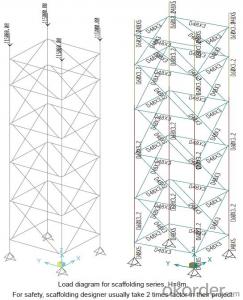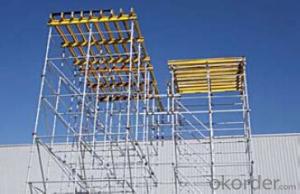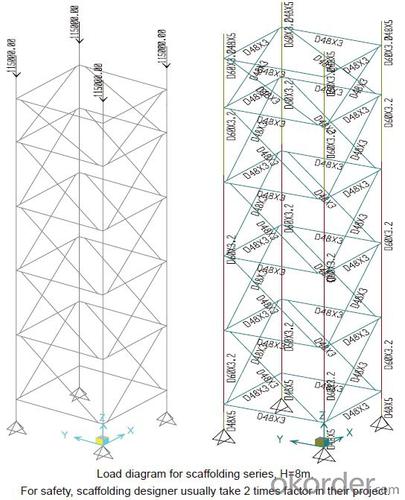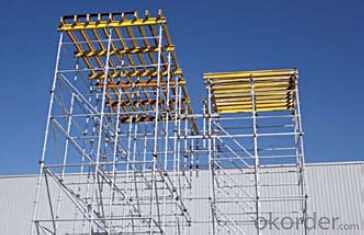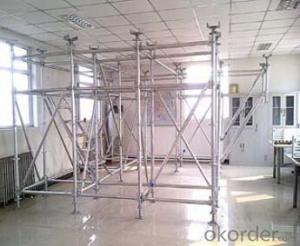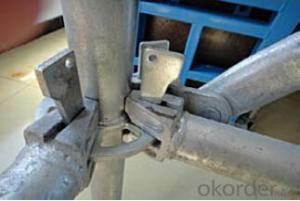Ring-lock Scaffolding accessories for formwork and scaffolding systems
- Loading Port:
- Tianjin
- Payment Terms:
- TT OR LC
- Min Order Qty:
- 50 m²
- Supply Capability:
- 1000 m²/month
OKorder Service Pledge
Quality Product, Order Online Tracking, Timely Delivery
OKorder Financial Service
Credit Rating, Credit Services, Credit Purchasing
You Might Also Like
Ring-lock Scaffolding
A support system for construction, ownsadvantages of both cup-lock scaffolding andshoring tower.
It is in the development direction of new typescaffolding.
It is widely used in buildings, bridges, tunnels etc..
Characteristics:
◆ Easy to storage and transportation
◆ High degree of standardization
◆ Easy and quick erection
◆ Excellent stability and bearing capacity
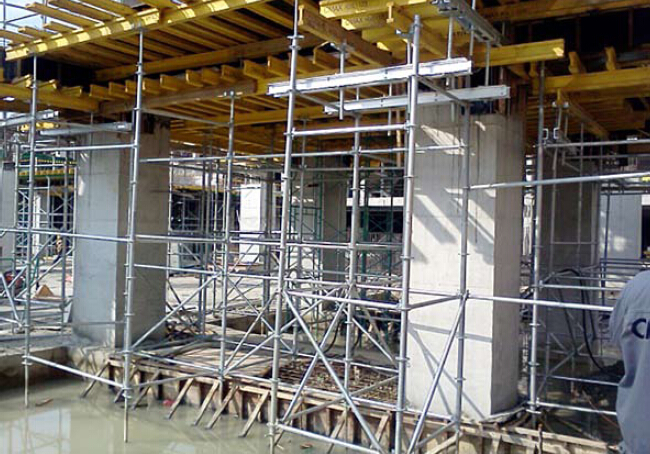
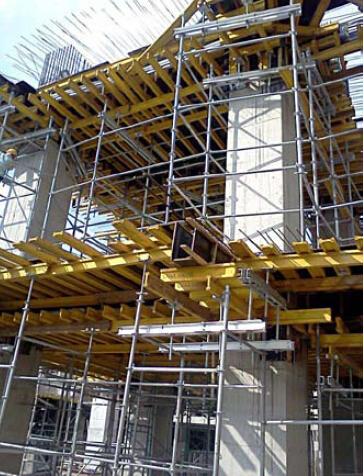
- Q: What is the standard thickness of steel formwork
- Opposite? The negative is not too clear. Generally if there is pellicle
- Q: Is steel formwork more expensive than other types of formwork?
- Yes, steel formwork is generally more expensive than other types of formwork. Steel is a durable and strong material, making it a preferred choice for construction projects. However, its higher cost compared to alternatives such as wood or plastic formwork can be attributed to the higher manufacturing and material costs associated with steel.
- Q: Are there any environmental benefits to using steel formwork?
- Using steel formwork in construction projects has numerous environmental benefits. Firstly, steel formwork is highly durable and can be reused multiple times, thereby minimizing the need for new formwork materials. This greatly reduces construction waste, as traditional materials like timber are often discarded after a single use. By opting for steel formwork, construction companies can decrease their environmental impact by reducing the amount of waste sent to landfills. In addition, steel formwork is recyclable, meaning that it can be recycled and repurposed into new steel products at the end of its lifecycle. This helps conserve natural resources and decrease the demand for raw materials. Moreover, the energy required to recycle steel is significantly lower than that needed for producing new steel, resulting in reduced greenhouse gas emissions. Steel formwork also offers advantages in terms of energy efficiency. Compared to traditional materials, it requires less energy for manufacturing and transportation, resulting in lower carbon emissions. Furthermore, its high strength and rigidity enable the construction of slender and lightweight structures, reducing material consumption and subsequently lowering energy requirements for heating, cooling, and lighting in buildings. Lastly, steel formwork is resistant to moisture, fire, and pests, minimizing the need for chemical treatments and preservatives that can harm the environment. This makes it a more sustainable option and reduces negative impacts on ecosystems and human health. Overall, utilizing steel formwork in construction projects provides several environmental benefits, such as reduced waste generation, increased recycling opportunities, energy efficiency, and reduced reliance on harmful chemicals. By choosing steel formwork, construction companies can contribute to a more sustainable and environmentally-friendly construction industry.
- Q: Can steel formwork be used for both straight and curved walls?
- Yes, steel formwork can be used for both straight and curved walls. Steel formwork offers high strength and durability, making it suitable for shaping walls of various shapes and sizes. It is highly flexible and can be easily adjusted and customized to create both straight and curved walls. The steel formwork system allows for precise and accurate construction, ensuring that the walls are built to the desired specifications. Additionally, steel formwork is reusable, making it a cost-effective choice for both straight and curved wall construction projects.
- Q: What are the different types of formwork bracing used in steel formwork?
- In steel formwork, there are various types of formwork bracing, each with its own unique features and benefits. Here are some of the most commonly used types: 1. Adjustable Steel Bracing: This bracing consists of adjustable steel tubes or rods that can be extended or retracted easily to the desired length. It allows for quick and easy installation and adjustment, making it ideal for projects with varying formwork heights. 2. Cross Bracing: Cross bracing involves diagonal steel members placed to create an "X" shape between vertical supports. It provides lateral stability to the formwork system and helps prevent buckling or deformation. 3. Tie Rod Bracing: Tie rod bracing uses threaded steel rods connected through formwork panels to provide extra strength and stability. It is commonly used in large-scale formwork systems that need to support high loads. 4. External Bracing: To increase stability against wind forces, taller formwork structures often use external bracing. Steel members are installed on the exterior side of the formwork system to resist lateral movement and maintain structural integrity. 5. Kickers: Kickers are diagonal bracing elements installed between formwork panels and the ground or a solid anchor point. They transfer lateral forces and prevent the formwork from tilting or collapsing. 6. Strut Bracing: Strut bracing involves placing steel struts or props vertically between the formwork panels and the ground. It provides additional support to prevent horizontal movement and ensure the stability of the formwork system. 7. Flying Bracing: When formwork needs support from above, such as in bridge construction or overhead structures, flying bracing is used. Bracing elements are suspended from overhead supports to provide stability and prevent formwork deformation. Each type of formwork bracing offers advantages and is chosen based on specific project requirements, including formwork height and size, expected loads, and site conditions. A combination of different bracing types may also be used to ensure optimal stability and safety.
- Q: What are the considerations when designing steel formwork for underground utilities?
- When designing steel formwork for underground utilities, there are several important considerations to take into account. These considerations include: 1. Structural Integrity: The formwork must be able to withstand the pressure and forces exerted by the surrounding soil and any potential external loads. It should be designed to provide adequate strength and stability throughout the construction process. 2. Water and Chemical Resistance: Underground utilities are often exposed to water and various chemicals. The formwork should be designed to be resistant to corrosion and deterioration caused by these elements to ensure its longevity. 3. Accessibility for Installation and Maintenance: The design of the formwork should allow for easy access during installation and future maintenance activities. This may include provisions for openings, removable sections, or access points to ensure that workers can easily reach the utilities when necessary. 4. Modular Design: Utilizing a modular design can provide flexibility and ease of installation. Modular formwork systems allow for quick assembly and disassembly, which can be beneficial when dealing with different underground utility layouts and configurations. 5. Safety: Safety is of utmost importance in any construction project. The formwork design should incorporate safety features such as guardrails, handrails, and anti-slip surfaces to minimize the risk of accidents and injuries during construction and maintenance. 6. Cost-effectiveness: The design should strike a balance between performance and cost. The formwork should be designed to minimize material usage and labor costs without compromising on quality and durability. 7. Compatibility with other construction methods: The design should be compatible with other construction methods and materials used for the underground utilities. This includes considerations for joining techniques, such as welding or bolting, and compatibility with other materials used in the construction, such as concrete or PVC pipes. By considering these factors, designers can ensure that the steel formwork for underground utilities is structurally sound, resistant to environmental factors, easily accessible for installation and maintenance, safe for workers, cost-effective, and compatible with other construction methods.
- Q: How is steel formwork cleaned and maintained?
- Due to its durability and reusability, steel formwork is commonly utilized in construction projects. To maintain its quality and ensure its long lifespan, it is crucial to perform regular cleaning and maintenance. Here are some guidelines for cleaning and maintaining steel formwork: 1. Eliminate concrete residue: After each usage, it is necessary to remove any concrete residue from the steel formwork. This can be accomplished by chipping away the hardened concrete with a hammer or chisel, being careful not to damage the formwork surface. 2. Utilize power washing: Once the larger pieces of concrete have been removed, a high-pressure water jet can be used for power washing. This will help dislodge any remaining concrete particles and dirt from the formwork surface. While power washing, it is important to observe appropriate safety measures such as wearing protective clothing and goggles. 3. Apply chemical cleaning: If stubborn stains or concrete deposits cannot be removed through power washing alone, a chemical cleaning solution can be employed. There are various concrete removers available in the market that can be applied to the formwork surface. It is essential to follow the manufacturer's instructions for proper usage and safety precautions. 4. Remove and prevent rust: Steel formwork is prone to rusting, which can compromise its structural integrity. Regularly inspect the formwork for any signs of rust and eliminate it using wire brushes or sandpaper. After rust removal, apply a rust-inhibiting primer or a protective coating to prevent further rusting. This should be done prior to storing the formwork to ensure its preservation. 5. Store properly: When not in use, it is important to store steel formwork in a clean and dry environment. Exposure to moisture, extreme temperatures, and corrosive substances should be avoided, as these can negatively impact the formwork's quality. Proper stacking and organization can also prevent damage and deformation during storage. Regular maintenance and cleaning are vital for the longevity and reusability of steel formwork. By adhering to these steps and taking necessary precautions during cleaning and storage, steel formwork can be preserved in optimal condition for future construction projects.
- Q: What are the different types of edge protection systems used in steel formwork?
- There are several types of edge protection systems used in steel formwork, including steel guardrails, toeboards, mesh panels, and safety nets. These systems are designed to prevent workers from falling or objects from being dropped off the edges of the formwork, ensuring a safe working environment.
- Q: Can steel formwork be used for complex geometric designs?
- Yes, steel formwork can be used for complex geometric designs. Its strength and durability allow for intricate shapes and patterns to be created, providing flexibility in design and construction.
- Q: Can steel formwork be used in areas with high wind loads?
- Yes, steel formwork can be used in areas with high wind loads. Steel formwork is known for its strength, durability, and stability, making it a suitable choice for construction projects in areas with high wind loads. The robustness and rigidity of steel formwork allow it to withstand the force and pressure exerted by strong winds, ensuring the safety and stability of the structure being built. Additionally, steel formwork offers a higher level of resistance to deformation and movement compared to other types of formwork materials, making it more reliable in areas prone to high wind loads. However, it is crucial to ensure that the steel formwork is properly secured and anchored to the ground to further enhance its resistance against wind loads.
Send your message to us
Ring-lock Scaffolding accessories for formwork and scaffolding systems
- Loading Port:
- Tianjin
- Payment Terms:
- TT OR LC
- Min Order Qty:
- 50 m²
- Supply Capability:
- 1000 m²/month
OKorder Service Pledge
Quality Product, Order Online Tracking, Timely Delivery
OKorder Financial Service
Credit Rating, Credit Services, Credit Purchasing
Similar products
Hot products
Hot Searches
Related keywords
